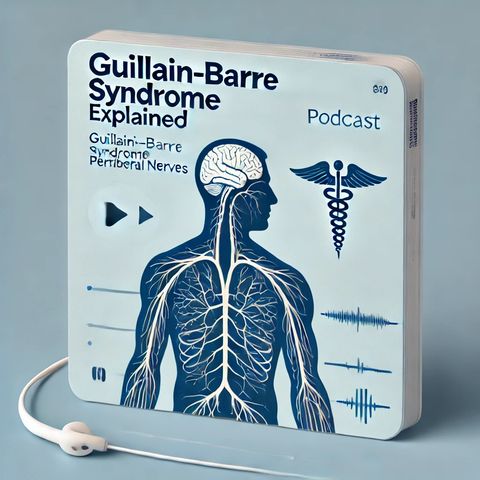What is Guillain Barre Syndrome?

Sign up for free
Listen to this episode and many more. Enjoy the best podcasts on Spreaker!
Download and listen anywhere
Download your favorite episodes and enjoy them, wherever you are! Sign up or log in now to access offline listening.
What is Guillain Barre Syndrome?
This is an automatically generated transcript. Please note that complete accuracy is not guaranteed.
Description
Guillain-Barré Syndrome: A Comprehensive Overview Guillain-Barré syndrome (GBS) is a rare but serious autoimmune disorder that affects the peripheral nervous system. Named after the French neurologists Georges Guillain and Jean...
show moreGuillain-Barré syndrome (GBS) is a rare but serious autoimmune disorder that affects the peripheral nervous system. Named after the French neurologists Georges Guillain and Jean Alexandre Barré, who first described the condition in 1916, GBS is characterized by rapid-onset muscle weakness and, in severe cases, paralysis.
Pathophysiology:
GBS occurs when the body's immune system mistakenly attacks the peripheral nerves' myelin sheaths or axons. This autoimmune response disrupts the transmission of nerve signals, leading to the syndrome's characteristic symptoms. The exact trigger for this autoimmune response is not always clear, but it often follows an infection or other immune system stress.
Causes and Risk Factors:
While the exact cause of GBS remains unknown, several factors have been associated with an increased risk:
Infections: About two-thirds of GBS cases occur after a respiratory or gastrointestinal infection. Common infectious triggers include:
Campylobacter jejuni (a bacterium often found in undercooked poultry)
Influenza virus
Epstein-Barr virus
Cytomegalovirus
Zika virus
Mycoplasma pneumoniae
Vaccinations: In rare cases, GBS has been associated with certain vaccinations, particularly the 1976 swine flu vaccine. However, the risk is extremely low, and the benefits of vaccination generally outweigh the risk of GBS.
Surgery: Some cases have been reported following surgical procedures.
Age and Gender: GBS can affect people of all ages, but it's more common in older adults. Men are slightly more likely to develop GBS than women.
Symptoms:
The symptoms of GBS typically develop rapidly over hours to days and may include:
Muscle weakness or tingling sensations, usually starting in the legs and spreading to the arms and upper body
Loss of reflexes
Difficulty with eye and facial movements, including speaking, chewing, or swallowing
Severe pain, especially at night
Difficulty with bladder control or bowel function
Rapid heart rate or blood pressure fluctuations
Difficulty breathing in severe cases
In its most severe form, GBS can lead to near-total paralysis, potentially affecting the muscles that control breathing and requiring mechanical ventilation.
Diagnosis:
Diagnosing GBS can be challenging due to its similarity to other neurological disorders. Doctors typically use a combination of methods:
Medical history and physical examination
Nerve conduction studies and electromyography (EMG) to assess nerve and muscle function
Lumbar puncture (spinal tap) to analyze cerebrospinal fluid for elevated protein levels without a corresponding increase in white blood cells
Blood tests to rule out other conditions
MRI scans to check for nerve root enhancement or swelling
Treatment:
While there is no cure for GBS, several treatments can help manage symptoms and speed recovery:
Plasma exchange (plasmapheresis): This procedure removes antibodies from the blood that may be attacking the nerves.
Intravenous immunoglobulin (IVIG): High doses of immunoglobulins are administered to block the damaging antibodies causing GBS.
Supportive care: This may include mechanical ventilation for breathing difficulties, physical therapy to prevent muscle atrophy, and pain management.
Rehabilitation: As patients recover, physical therapy, occupational therapy, and speech therapy may be necessary to regain strength and function.
Prognosis:
The prognosis for GBS varies widely among individuals:
Most people with GBS eventually recover, although the time frame can range from a few weeks to several years.
About 80% of patients can walk independently six months after diagnosis.
Approximately 60-80% of patients make a full recovery, but may experience residual weakness or fatigue.
5-10% of patients may have severe, long-term disabilities.
The mortality rate is estimated at 4-7%, usually due to complications such as respiratory failure or cardiac arrest.
Ongoing Research:
Scientists continue to study GBS to better understand its causes and develop more effective treatments. Areas of research include:
Identifying specific autoantibodies involved in GBS to develop targeted therapies
Exploring the role of genetics in GBS susceptibility
Investigating new immunomodulatory treatments
Improving rehabilitation techniques to enhance recovery
Guillain-Barré syndrome remains a complex and challenging condition. While most patients eventually recover, the journey can be difficult and prolonged. Ongoing research and improved treatment protocols offer hope for better outcomes for those affected by this rare but serious disorder.
Information
| Author | QP-4 |
| Organization | William Corbin |
| Website | - |
| Tags |
Copyright 2024 - Spreaker Inc. an iHeartMedia Company
